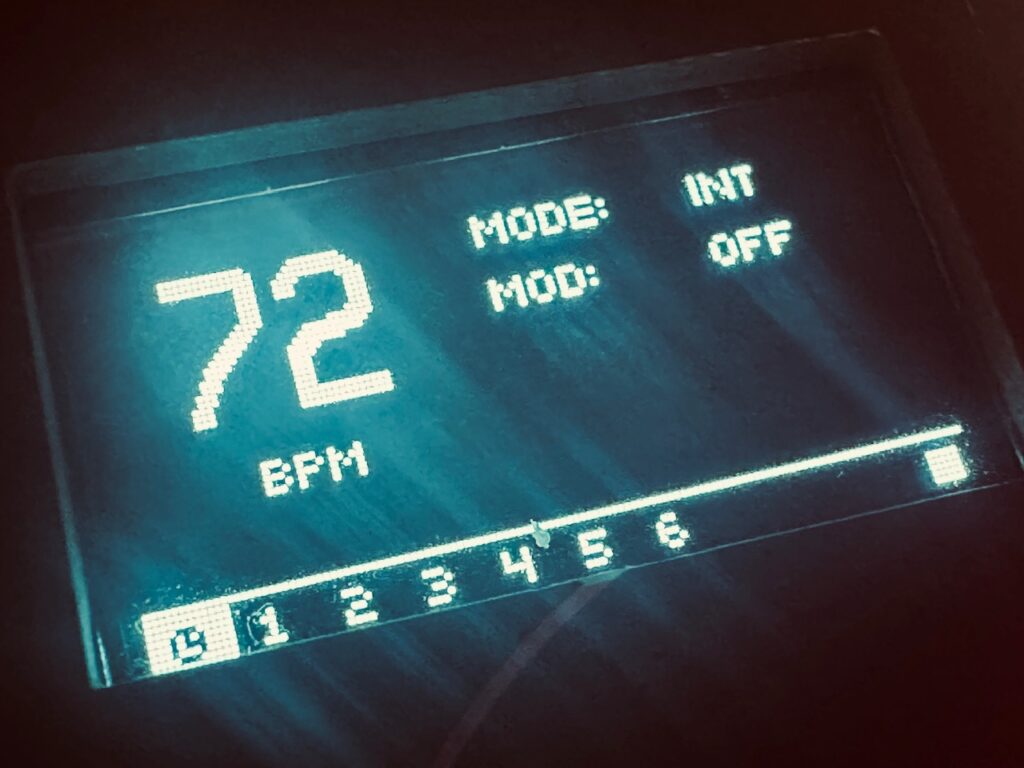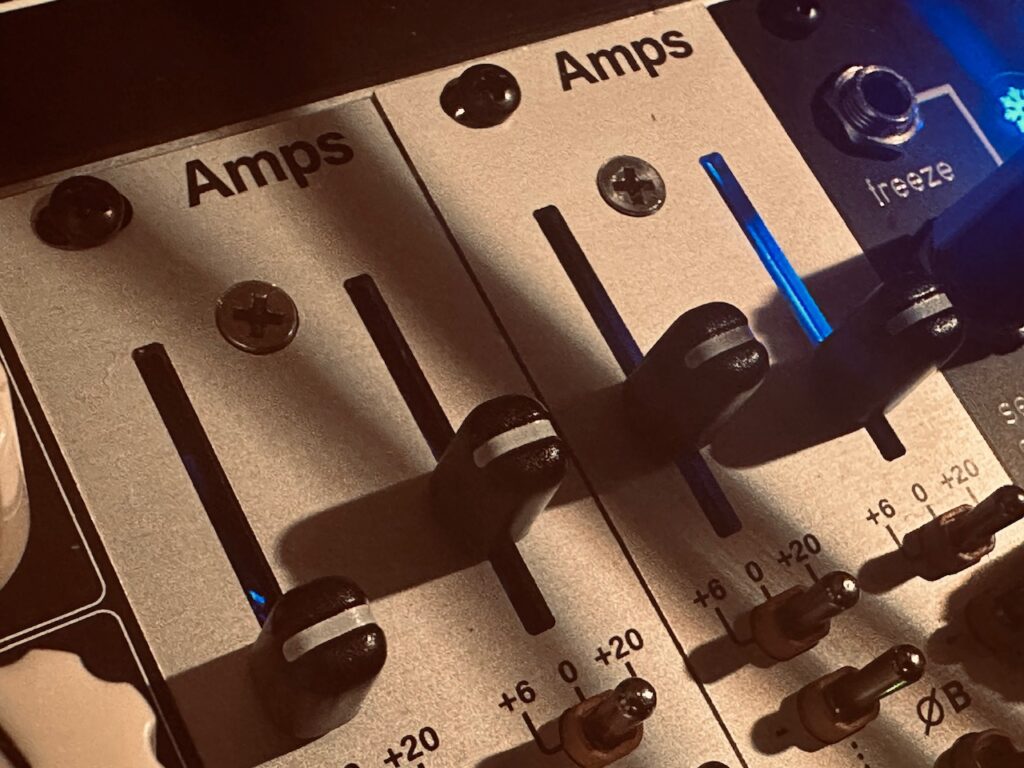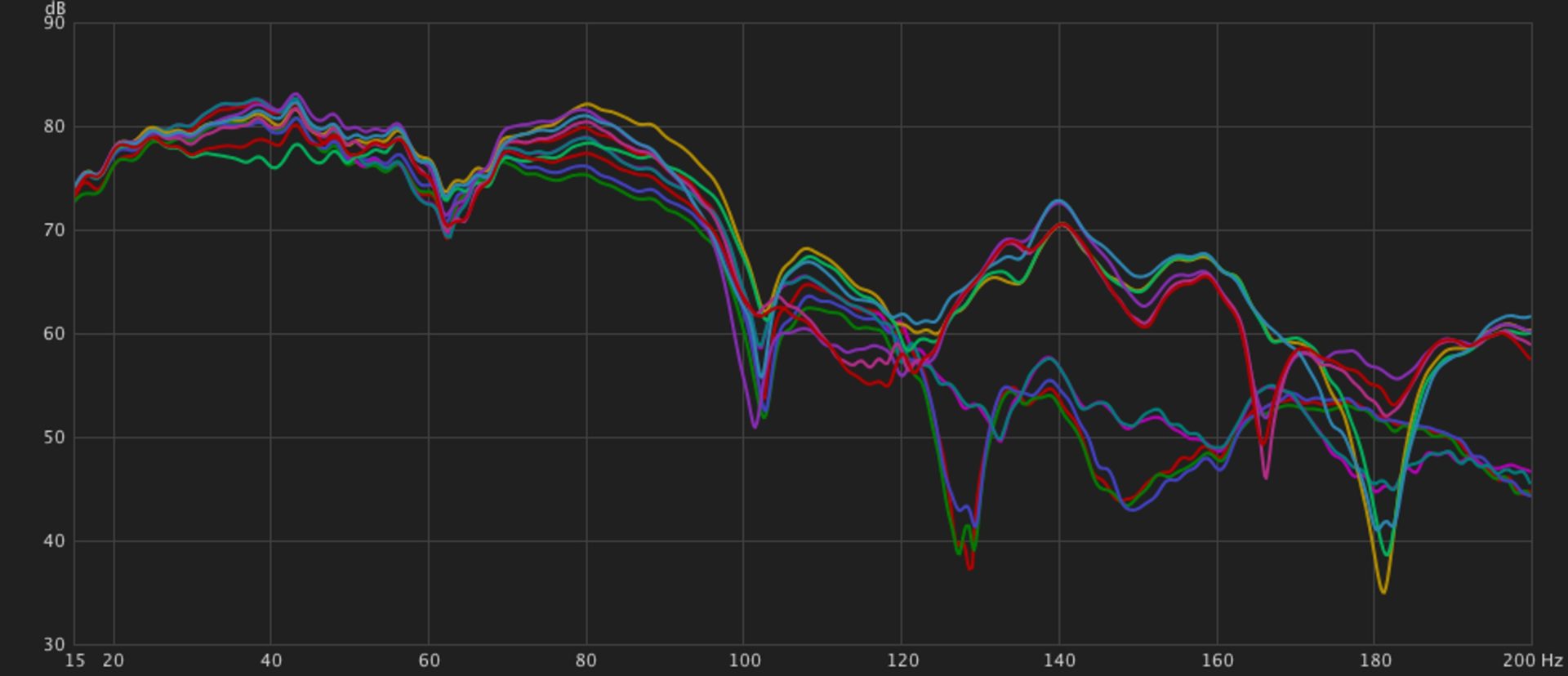While I was testing a synth I built for my brother and me to play while on a family vacation, I wanted to see if I could get something more ambient from what I perceived as a more rhythmic-oriented case. I have a master clock, a sequencer, a chaotic/random gate producer that likes the time grid, all dedicated to staying in time. My brother is more of a shake your booty type of guy and I wanted to bring something he would enjoy too, so rather than chaos and random ahoy, I put in several modules that he could feel comfortable with too. But rather than resign myself to grid based tempos and rhythms from this synth, I ventured to see how I might go about creating something more freeform. Instruments tends to direct their players towards certain ways of doing things. Modules do the same via their UI cues. All modules demand some particular workflow which lends towards different styles as a result of their design. But this subtle push by module makers doesn’t preclude using their designs in ways that maybe they weren’t designed to be used, or in ways they hadn’t considered. Individual case builds likewise push musicians to patch in certain ways.

Since this was a test, I started with a familiar idea and tried to see how I might create an irregular clock in order to use Stochaos to hit the Disting Ex in the SD Multisample mode using the LABS Soft Piano samples. It’s one of my favorite voice patches, and generally it sounds beautiful. Enter the Sitka Instruments Gravity.

The Gravity is a 6hp, 6 output master clock. It doesn’t have the sorts of clocked modulation options that something like the ALM Busy Circuits Pamela’s Pro Workout has, nor does it have the quick, hands on manipulation of the Make Noise Tempi. But it does have a fair few things going for it. It’s a rock solid clock, and easy to manipulate, even at first glance. The UI is intuitive, and its distractions few. Each output has three modes: Clock, Probability Clock, and Sequencer. The clock and probability clock does what it says. The outputs put out short triggers according to a clocked division or multiplication of the master tempo.1 Timekeeping is not exciting, however it is crucial. But the killer app in the Gravity is that its tempo can be modulated by control voltage, a feature not found in every master clock. At this realization I knew just exactly how I was going to get my wonky clock.
After plugging in a smooth random LFO from Batumi II + Poti II and tuning its frequency and amplitude to taste, we had a modulating clock that randomly floats above and below the master tempo. The Gravity gives a numerical option when the master tempo is being modulated, called Range. It’s simply a number that goes up by tens. Although initially I wasn’t sure just exactly what that number represents, the developer noted that it’s a fixed maximum BPM deviation above and below the set master tempo. So if your tempo is set to 80bpm, for example, with a Range of 10, it will swing as low as 70bpm with -5v of CV, and as high as 90bpm with +5v of CV. Clever. Subtle undulations is one thing. Wild tempo fluctuations is something else altogether, and having a defined maximum range built in to the modulation is a really good way of making it easier. This clock was fantastic, subtly shifting faster and slower. Being anticipated, while not being predictable, and never on a strict grid. Perfect.

Although I didn’t need more triggers than what Gravity can supply to ping the Disting Ex, I did want those triggers to extend laterally, never close to anything we could call a pattern. Stochaos once again provides a beautifully timed spread of triggers which form the basis of the piano voice in the patch. It always takes some clock adjustments to get the triggers just so. In this patch I ultimately used a x8 multiplication of that modulated clock with a 20% chance of skipping a beat to drive Stochaos. This kept triggers coming at a reasonable pace for Stochaos to spread the gates through its various outputs, helped by the retrigger setting in the SD Multisample algorithm to “Synth” to keep it from going too cluttered with notes.
For pitch, I used three of the four Swell Physics outputs into Quantermain (in C major). One of the quantizers was set to quantize to all 7 notes in the scale, with the other two set to quantize only to the root, third, and fifth. This turned out to be a wonderful method of getting pitch. The outputs on Swell Physics are all inter-related, and something akin to phased LFOs, only the phasing is more organic. Swell Physics is not a single speed with waves sliding back and forth, but the movement of the ocean, with ebbs and flows that can’t be strictly controlled, and where each wave affects the others. All of their speeds fluctuate, as do their amplitudes. This set of waves allowed for a good spread of notes, with minimal dissonance.
The Soft Piano sample outputs from Disting go to the Qu-Bit Nautilus for some unclocked delay. Feedback and Depth are lightly modulated by the highly attenuated AVG output from Swell Physics, while a highly attenuated saw ramp LFO from Batumi II + Poti II modulates Reversal. The patch starts with no Chroma (Qu-Bit speak for an effect inserted into the delay feedback path), but heavy distortion is introduced later on as the patch heightens. Using the delay feedback line for distortion, as opposed to using distortion before the delay, still allows for the piano notes to sing through quite clear, before being clipped to hell over and again as the repeats fade away.

After going through Nautilus, the signal made its way to the Make Noise QPAS for some light HP filtering. In most situations I would run a hard clipped signal through a LP filter to shave off some of the most egregious harmonics, but for some reason I preferred the HP filtering in this patch (I tried all four stereo outputs before deciding on HP filter), and so I won’t be too harsh on myself for an intentional decision made in the moment. The only modulation is via the 1 < 2 and 3 > 4 gate outputs on the Swell Physics via the CuteLab Missed Opportunities to both !!¡¡ inputs for some occasional shooting stars.

But getting a pretty flow of random piano notes wasn’t the final goal. The final goal was to test the new elements of this case so I’d have a basic understanding of how to use the case in a style I enjoy, and hopefully avoid having to constantly dig through manuals during the little time I’d have to patch on the trip, which brings me to a real beast of a module: the new Doboz T12, a 17hp (😕) touch controller, arpeggiator, and sequencer. I had half-assedly tried to get it going a couple of times over the last couple of weeks, but came up empty both times, so it was time to sit down with the manual and dig in.
At first I was intimidated by the T12. There’s not much on the panel outside of 12 touch plates, a screen, a couple of buttons, and an encoder to give you cues, and the options in the screen are many. But once I got over the initial hurdle of Step 1, the intuitive nature of the screen UI took over, which makes it generally simple to navigate and use. The T12 has 4 modes: a touch controller, an arpeggiator, a very straightforward up-to-32 step sequencer, and a more complex extended functionality step sequencer. Although I certainly want to understand the Complex Sequencer, my aim was to tackle the touch controller (why I initially bought the T12 to begin with), the arpeggiator, and the simple step sequencer.


Despite being a bit overwhelming at first glance, having loads of options in the UI, the T12 workflow is both fast and intuitive. Not only are there the standard pitch CV and gate outputs, but also a secondary CV output for something other than pitch. You can set vibrato, including a delay, gate probability, random note probability, touch behaviors, and many other facets of your sequence quickly and easily. The AUX CV output can send envelopes, slewed gates, secondary raw CV, amongst other stuff. The T12 is a really powerful, highly flexible, and intuitive module that is fun to use. Just don’t forget to save your work in one of the many save slots, or else you’re gonna lose all your shit. Ask me how I know. Fortunately this particular patch is pretty easy to reproduce should I have the need.
For this initial patch I wanted to keep sequencing as simple as possible. A slowly plodding 10 note, repeating sub-bass line via the Humble Audio Quad Operator that would flood the audio and shake the room. I was loosely aiming for a post-rockish feel in the progression. It’s intentionally loud, though not so loud that the piano can’t still be clearly heard. With the wandering clock set to /8, and after a smidge of tuning the individual notes in the sequence to what I wanted, I pretty quickly got what I was after.
Which isn’t to say that the bass line is without issues.
Firstly, I’d like to note that both the high level and super-low frequencies were exactly what I was trying to accomplish. I was looking for film score kind of epic. The kind of bass that rattles walls and that you can feel in your stomach. That said, there’s far too much audio gear, including very high quality audio gear, that has a difficult time reproducing C1 (32.70Hz). My audio monitors, a set of Focus Alpha 80 studio monitors only reach down to 38Hz before the cutoff becomes pronounced. At 32Hz, the tone could still be heard, but not with near the authority it should have. D1 (36.71Hz) had similar issues, although not nearly as marked. By the time we get to E1 (41.2Hz) things are booming, but of the 10 notes in the bass sequence, only 5 can be heard with the vigor I intended, and that’s through a good pair of studio monitors. Fortunately the cans I used to record this patch, a set of GK Ultraphones, and the AirPods Max Bluetooth headphones I use for general listening, have no pronounced problems with reproducing the low C. But if I were to record this patch again, and I’m highly considering it, I’ll pitch the entire piece up 4 full semitones (E1) to avoid that conundrum. It’s one thing for a bass heavy piece to not play through phone, tablet, or laptop speakers. It’s a different sort of problem when high quality studio gear can’t do it. Any system with a subwoofer should really shake the foundation, but you shouldn’t need a subwoofer to properly hear music.
The last voice was a spur of the moment addition to the patch. I didn’t know exactly what, but I knew the patch was missing something. It needed one last final touch. It needed Plaits. Though it certainly has its limitations, Plaits is one of the most versatile and best sounding oscillator modelers available. Everything from kick drums, a scaled down Rings algorithm, and FM, plus more is possible with Plaits. At first I didn’t really know what I wanted, other than it be sparse. The Rings algorithm didn’t really fulfill the role. It took away from the patch as much as it added to it.
But as I made my way through the modes one by one, I landed on the final green algorithm: Vowel and speech synthesis. This would normally be unremarkable, but as it happened, I kept hearing the word “Red.” How the various knobs had been set while testing other algorithms landed me smack at the beginning of the colors of the rainbow. I slowly turned the Morph knob to see what else was hidden there, and found a slew of words. At first I set up modulation of the Morph to cycle through the words quickly. Think Robot Auctioneer. And although this addition certainly moved me in the right direction, it still wasn’t the destination. There were too many words being synthesized too quickly. It was slightly distracting, and not wholly complementary.
After a bit of envelope experimentation, I settled on 4 words: Red, Orange, Yellow, Green, “said” at a slightly slower than “natural” pace, and with a fairly thin tone. This gives the voice an almost sad feel, which I think slightly tempers the optimism and hope found in C major piano alongside an epic bass line. It brings a bit of the non-perfection and often lonely feel of reality back into scope, and that even non-perfection and loneliness can be contained within beauty.
After repeated listens, I know that I wouldn’t send any pitch information to Plaits were I to record this again. I think having it repeat at the same pitch would have an even larger impact, and be more focused.

One last new module I used is the Intellijel Amps VCA. Two of them chained, actually. Although I initially planned and built this case with an Intellijel Quad VCA, I recently realized the power of fully cascading VCAs,2 and decided to replace one of my Quad VCAs with this pair of Amps. Even with the first use I could see the utility in cascading inputs. The ability to patch one input and get out several signals that are related, yet separately attenuated and/or modulated, for use throughout a patch is powerful. Of course multiple related outputs could also be accomplished by patching multiplied copies of the signal into all four VCA inputs, but with cascading inputs we can eliminate at least six patch points and three patch cables. Efficiency is key. Add in ring modulation and signal inversion, and Amps is a powerful tool indeed.
Modules Used:
Sitka Instruments Gravity
Doboz T12
Nonlinearcircuits Stochaos
Expert Sleepers Disting Ex
Humble Audio Quad Operator
Mutable Instruments Plaits
Mutable Instruments Veils
CalSynth Changes (MI Stages) (w/ quimem)
CalSynth uO_C (w/ Phazerville)
Addac Systems Addac508 Swell Physics
Xaoc Devices Batumi II + Poti II
Make Noise QPAS
Intellijel Amps
Qu-Bit Electronix Nautilus
Blue Mangoo Stratosphere Cloud Reverb (AUv3 plugin)
Performed and recorded in 1 take in AUM on iPad via the Expert Sleepers ES-9.
*****
- According to the developer, Gravity should (fairly) soon get a firmware update which adds the ability to adjust gate duty size as a prominent feature, rather than only short 15ms triggers. This addition would make the Gravity outputs far more useful as a clocked modulator, and make it able to trigger longer ASD or ADSR envelopes that are determined by gate length. The developer has also noted that MOAR divisions and multiplications of the master tempo will be added.
- A fully cascading VCA is one in which all inputs, CV inputs, and outputs are normalized to the following channel until the normalization is broken by a plugged in jack. This configuration allows for a flexible array of both CV and audio patching, capable of complex mixes or routing.

